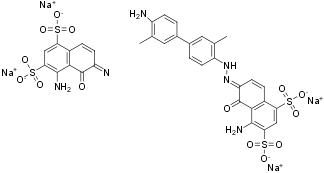Overview
- Price, C.J. and Raymond, L.A. (1996) Mol. Pharmacol. 50, 1665.
 Alomone Labs Evans Blue tetrasodium salt reversibly inhibits AMPA receptors heterologously expressed in Xenopus oocytes.Inhibitory effect of 20 µM Evans Blue tetrasodium salt (#E-110) on GluR1 currents, elicited at -80 mV holding potential by continuous stimulation with 10 µM glutamate (indicated by uppermost horizontal bar).
Alomone Labs Evans Blue tetrasodium salt reversibly inhibits AMPA receptors heterologously expressed in Xenopus oocytes.Inhibitory effect of 20 µM Evans Blue tetrasodium salt (#E-110) on GluR1 currents, elicited at -80 mV holding potential by continuous stimulation with 10 µM glutamate (indicated by uppermost horizontal bar).
- Seeburg, P. (1993) Trends Neurosci. 16, 359.
- Lessmann, V. et al. (1992) Neurosci. Lett. 146, 13.
- Keller, B.U. et al. (1993) Proc. Natl. Acad. Sci. U.S.A. 90, 605.
- Yen, L.F. et al. (2013) PLoS One 8, e68595.
Glutamate is the major excitatory neurotransmitter in the mammalian central nervous system and detailed knowledge of the properties of glutamate receptors is essential in understanding excitatory synaptic transmission in the brain. Glutamatergic transmission at excitatory synapses is mediated by three different classes of receptor-gated ion channels: AMPA receptors (α-amino-3-hydroxy-5-methyl-4-isoxazole propionic acid), Kainate receptors and NMDA receptors (N-methyl-D-aspartate)1.
The biphenyl derivative of 1,3-naphthalene disulfonic acid, known as Evans Blue tetrasodium salt, was found to reduce desensitization and partially block the peak amplitudes of non-NMDA-receptor mediated currents in rat thalamic neurons2, and to block kainate evoked currents of heterologously expressed recombinant AMPA receptors containing either subunit GluR1 or GluR2 (IC50 values are 220 µM)3. Evans Blue has been an important tool in many physiological and clinical investigations because of its high affinity for plasma albumin4.
Evans Blue tetrasodium salt (#E-110) is a highly pure, synthetic, and biologically active compound.

